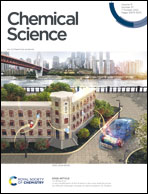Size-dependent properties and unusual reactivity of novel nonplanar heterocycloarenes†
Abstract
The solution-phase synthesis of (hetero)cycloarenes with a well-defined size and geometric structure remains a challenging topic in organic chemistry and materials science. Herein, two novel nonplanar N,S-heterocycloarenes (PTZ1 and PTZ2) containing two/three alternate phenothiazine-co-phenanthrene units were conveniently synthesized. The smaller size heterocycloarene PTZ1 adopts a unique butterfly-shaped geometry and shows moderate supramolecular host–guest interactions with both fullerenes C60 and C70; whereas the higher homologue PTZ2 has a saddle-shaped conformation and demonstrates no obvious encapsulation with C60 or C70. Meanwhile, benefiting from the relatively ordered molecular packing, the thin film of PTZ1 behaved as a p-type semiconductor, while the more distorted PTZ2 does not display any field-effect characteristics. Particularly, upon the oxidation of heterocycloarene PTZ1 by Oxone, an unusual bis(sulfone-co-orthoquinone) product PTZ1-Oxi with an arc-shaped geometry is obtained and identified by single-crystal X-ray analysis. Our findings markedly expand the known chemistry of (hetero)cycloarenes and open a new path for their further functionalization.



 Please wait while we load your content...
Please wait while we load your content...